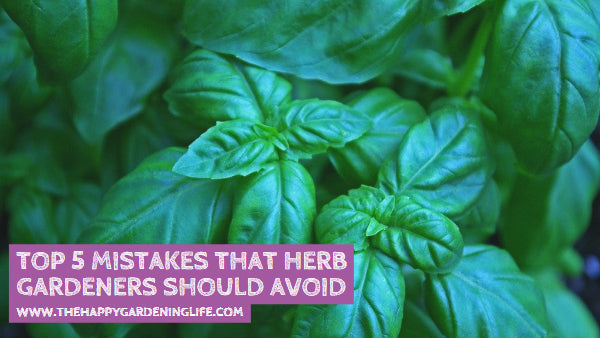
Top 5 Mistakes That Herb Gardeners Should Avoid
Share
 It’s natural to encounter some mishaps when you’re herb gardening for the first time. But if it happens way too often, then you need to address this issue right away to prevent further problems in the future.
It’s natural to encounter some mishaps when you’re herb gardening for the first time. But if it happens way too often, then you need to address this issue right away to prevent further problems in the future.
The first thing you want to be careful of is choosing the wrong varieties. Don’t just go with any herb that’s available; you’ll want a good trainer herb that’s easy to grow and maintain. Basil fits these criteria well, that’s why it’s highly recommended for new herb gardeners.
Another common mistake is watering your herbs only once a week.
Most herb plants actually need a moderate amount of water daily; weekly watering is not enough for them especially during summer. So remember to water your herbs regularly and moderately and they will thrive better.
For more herb gardening mistakes and how to prevent them, go ahead and check out this handy list from The Skinny Gourmet. Feel free to share it on your favorite social networks!
Common Mistakes That Herb Gardeners Make
Mistake 1: Starting with the wrong varieties.
I recommend you start by trying to grow fresh basil. It is the perfect trainer herb. First, basil grows quickly, allowing you to observe the effects of your care more easily. Second, basil leaves wilt visibly when not watered enough, but recovers well if you water the wilted plant. This makes basil a great ‘canary in the mineshaft’ to help you figure out how much water is enough.
Mistake 2: Watering herbs like houseplants.
Instead, water herbs a moderate amount every day. While some houseplants flourish with one solid watering per week, most delicate herbs require moderate and regular watering. This is particularly true during hot summer months. If you have good drainage at the bottom of your pot (at least a drainage hole, possibly rocks beneath the soil), it will be difficult to water herbs too much.
Mistake 3: Not cutting early and often.
Basil is a great herb to practice pruning. As with all herbs, you want to cut the herb just above a set of growing leaves. With basil, when you cut the plant that way, the originally trimmed stem will no longer grow. However, two new stems will grow around the original cutting, creating a “V” shape. If you don’t trim basil aggressively, it will continue to grow straight up, and become too tall and top-heavy.
Making your first trim approximately 3-4” above the soil produces a nice sturdy plant. Of course you want to be sure you are always leaving a few good sturdy leaves on the plant. As it continues to grow, continue to prune it approximately every 3-4″ for a nice solid plant. Let it grow for some time and then cut back to within 2-3 inches of the original cut. After only a few early trial cuts, this usually makes for a nice clipping with plenty of basil to use for a pizza.
Mistake 4: Taking the leaves from the wrong place.
When you are just starting out it seems to make so much sense to pick off a few big leaves around the bottom of the plant, and let those tender little guys at the top keep growing. Wrong. Leave those large tough old guys at the bottom alone. They are the solar panels that power your herb’s growth.
Once your plant is big enough to sustain a decent harvest, keep on taking from the top, as you have been when you were pruning. That way you get all those tender new herbs that are so tasty, and your plant gets to keep its well developed solar power system in place. Plus, if you pluck from the base and leave the top intact, you get a tall skinny plant that will flop over from its own weight.
When you pluck from the top, instead of clipping off just below a pair of leaves, you want to clip off just above a pair of leaves. Promise, it works. The place where the leaf joins the stem is where new growth will occur when your plant sends off new stems in a V.
Mistake 5: Using tired soil with no nutrients.
Tired soil that has been sitting in your garden or lawn for ages often looks grey and a little depressing. Would you want to grow in that stuff? Give your plants a dose of the good stuff and they’ll thank you for it. Grow your herbs in a combination of potting soil, used coffee grounds (with a near-neutral PH, available for free at Starbucks), and organic compost. Add as well some in crushed egg shells.
Article Source: skinnygourmet.blogspot.com
For further tips on herb gardening, check out this guide on When to Harvest Basil by LoyalGardener.com
